
© Lemon squeezer
Sound the drums, sound the trumpets: the first color electronic ink e-reader intended for the general public is available in France! This technology, timidly appearing on a few confidential products, has made the geeks of the planet salivate.
The first to try it in France was Vivlio with Color, whose distribution remained confidential. But this time, it's heavy since it's Rakuten which is interested in the subject, through its Canadian subsidiary Kobo. It is therefore FNAC which will mainly distribute the Clara Color and Libra Color, the first models available.
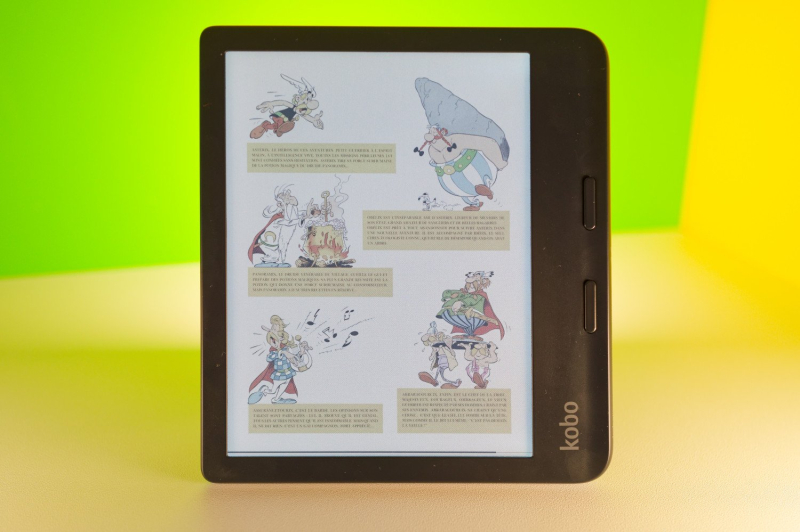
© Marc Mitrani for Presse-citron
Is this a simple evolution or a revolution in low-power display ? Does color really add anything ? To find out, we spent a few weeks with the Libra Color. This high-end model can be optionally equipped with a stylus to allow note-taking.
Before going any further, it may be good to recall what electronic ink is. The main characteristic of an electronic ink panel is that it consumes very little energy. Without going into technical details, we note that an electrical impulse is only necessary when generating a new page, this remaining visible once the power is cut.
Significant disadvantages
While it limits power consumption, electronic ink is not the fastest display technique, far from it. Depending on the technology used, it takes between 0.5 and 1.5 seconds to display an image. We are far from the 60, even 120 fps offered on traditional LCD panels.
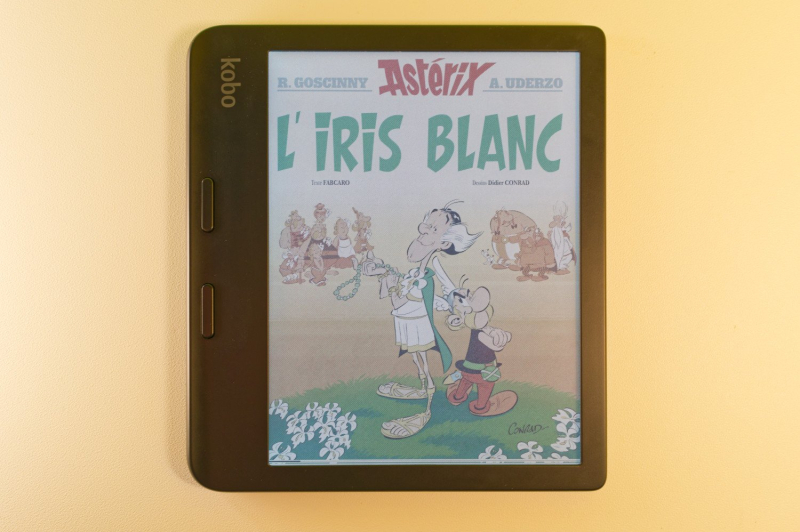
© Marc Mitrani for Presse-citron
In addition, displaying a new page (or image) does not completely erase the previous one, which deteriorates visual comfort after a few pages browsed. To remedy this, e-readers “reset” regularly flashing the screen briefly every 2 or 3 pages.
And the color was!
The color version is based on the same technology to which is added a matrix of colored filters. Kobo uses a 7″ diagonal Kaleido 3 panel here designed by the company E-Ink. It is capable of reproducing 4096 shades at 150 ppi (or 300 ppi in monochrome), current technology not allowing much better.
Concretely, what does color bring to this e-reader? Both not much… and a lot! Not much, if you just read traditional works. In this case, the illustrations they contain will benefit from this new feature (notably the cover of electronic books).
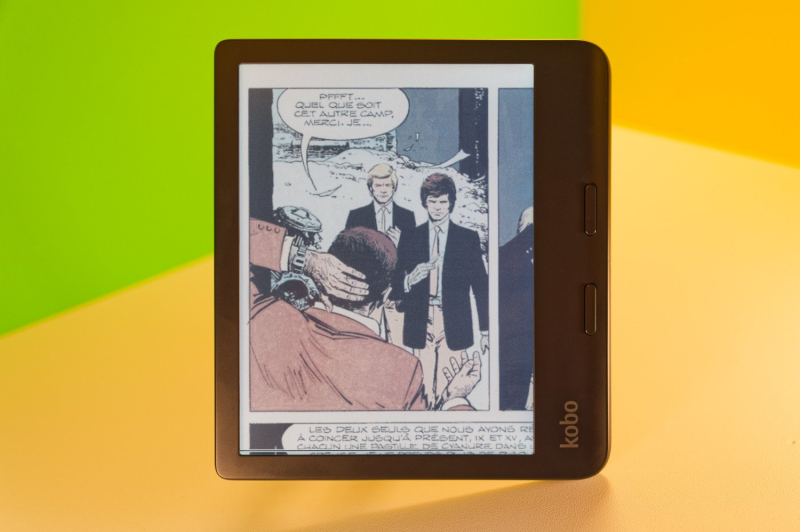
© Marc Mitrani for Presse-citron
On the other hand, it will be much more appreciable for reading comics or richly illustrated works, provided that you make do with the reduced display size. Small problem, however: the bubbles of a comic strip or the legends of a graph designed for reading in A4 format are not obvious on a 7'' screen.
You will therefore have to zoom in on the drawing in order to successfully read the text. This can quickly become boring, as the operation turns out to be slow. Or, settle for works in a more compact original format, such as manga, generally published in pocket format.
Even though color electronic ink looks promising, it is not yet perfect. The colors are very pale and do not reflect the reality of the document displayed. The e-reader's processor is not at all slow, especially when it comes to moving around a graphic page.
As you can see, we were left a little unsatisfied. The color aspect, however, is much more interesting if you use the Libra Color as an electronic notepad.
Like the Ellipsa 2E, the Libra Color allows the use of a stylus to highlight, draw or take notes. To do this, you will need to purchase the Kobo Stylus 2 (70 euros). Equipped with a side function key and a digital eraser, it recharges via USB-C. No internal location is provided to receive it, but it attaches to one of the sides using magnets when not in use.
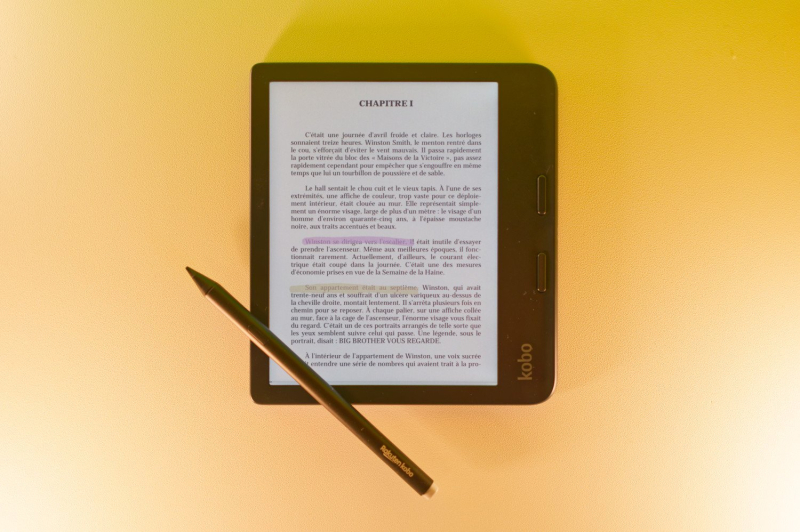
© Marc Mitrani for Presse-citron
Kobo offers two types of notebooks. The basic one allows you to write anywhere, exactly as you would on a sheet of paper. paper. It's perfect for scribbling sketches or taking notes quickly. The advanced notebook allows handwriting recognition as well as more advanced layout, for example the insertion of diagrams or mathematical equations.
Using the Libra Color as a notepad is pleasant. Special mention for the handwriting recognition, which is really efficient. We also appreciate the possibility of exporting notebooks to Google Drive, Dropbox or a computer (USB-C connection) in Word, text or HTML format. Too bad the PDF is not offered: this standard is readable on many devices.
Of course, the Libra Color is above all an e-reader intended for electronic books. These can be acquired from the Kobo online store, available from the interface, or imported into the 32 GB of storage memory. In this case, we will use a USB cable or synchronization with the Dropbox or Google Drive cloud.
The reading interface is very easy to use and does not really change compared to that of previous models. Depending on their format and the integrated protection mechanisms, it is possible to add annotations, highlight text or even draw with a stylus. All with a little latency, surely due to the youth of color electronic ink.
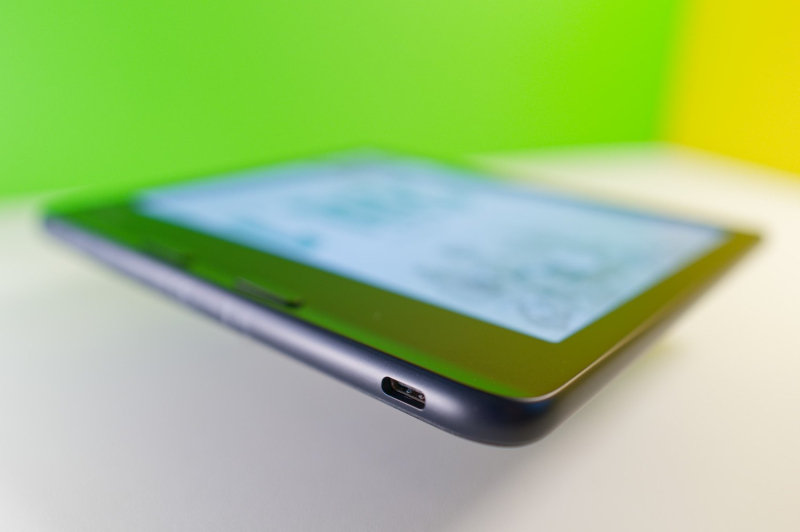
Charging and connection to a computer are ensured by the USB-C port © Marc Mitrani for Presse-citron
Another interesting function, playing audio books that you can buy in the online store.As the tablet does not have a speaker, you will need to have a Bluetooth headset in order to listen to them. The result is more than satisfactory, except for one detail: you must stay on the audio player page, as the device does not seem to support true multitasking. It is therefore impossible to draw or write while listening to a book. Too bad.
And the autonomy, in all this ? It turns out to be very good, even excellent. In mixed use ( reading books, taking colored notes, listening to audio books), our test copy reached three weeks of autonomy. To do this, we kept the default settings (standard page refresh and automatic adaptive backlighting).
Last but not least, the Libra Color benefits from an IPX8 certification allowing it to survive immersion for up to 60 minutes at a depth of two meters in clear water.
The Libra Color from Kobo is one of the very first e-readers equipped with a color screen. And for a first try, it is clear that the result is encouraging… but not perfect. The main criticism that will be made of it is the paleness of the colors displayed which makes obtaining a faithful rendering illusory.
In addition, the small size of the screen does not make it easy to read classic comics, but lends itself quite well to the compact format of manga. We appreciate the possibility of using the device as a notebook provided you purchase an optional style.
Good point also for synchronization with the Dropbox and Google Cloud clouds, for reading audio books and especially for the handwriting recognition function capable of deciphering writings ([(illegible)]) with complex spelling. Importing unprotected ePub and PDF files is interesting, but we don't understand why exporting notebooks to PDF is not offered.
There remains the question of price. Sold for 230 euros at launch, the Libra Color remains expensive given the size of its screen. That's the price you pay for using technology as new as this.
📍 To not miss any news from Presse-citron, follow us on Google News and WhatsApp.

